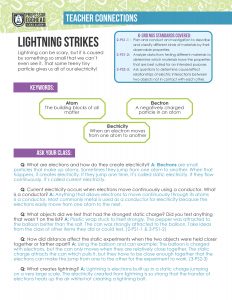Lightning can be kind of scary, can’t it? Well, what if I told you that it’s caused by something so small that you can’t even see it? And what if that same teeny tiny particle was also what gave us all of our electricity? This week, we’re talking the big and the small about Lightning and Electricity! Let’s just say…. Don’t worry about combing your hair for this lesson.
Keywords
- Lightning
- Electron
- Static Electricity
- Current Electricity
materials list
- 1 inflated balloon
- Plastic straw with the wrapper
- Salt
- Pepper
- A plate
- Plastic Wrap
- Sheet of Paper towel
- Cloth or rag
- 1 empty aluminum can
- Optional: Thin plastic produce bag + scissors
- Optional: Flashlight
background
Atoms want to be neutrally charged by having the same number of protons and electrons. If a positive charge is close to an atom, it may pull an electron away, since negative charges are attracted to positive charges. When an atom loses an electron, it has an overall positive charge. This now positively charged atom will try to find another electron to become neutral again. This can happen in reverse as well. An atom that gains an electron becomes negative, and will try to lose an electron to become neutral again. As electrons move between atoms, that movement is what creates electricity.
There are two kinds of electricity, current and static. STATIC ELECTRICITY is an electrical charge created when electrons make a single jump. We generally experience it as a result of friction. If you shuffle your feet across the carpet and then touch the doorknob, you might get a shock - that’s static electricity. As you move, you pick up a lot of extra electrons from the carpet. Your atoms don’t want the extra electrons, so they get rid of them by moving them to the doorknob. You perceive that electron movement as a shock. You might even see a spark or hear a crackle. The electrons travel to the doorknob because it is made of metal, which is a conductor. Conductors allow electricity to flow through them. Lightning is an example of a huge spark of static electricity caused by the buildup of electrons in clouds. The electrons move in a giant bolt between the cloud and the ground or between the cloud and another cloud. The average bolt of lightning is 6 miles long and travels at 140,000 mph! Lightning strikes have been known to reach temperatures of 54,000 degrees Fahrenheit, hot enough to make the air glow (that’s what you see as a bolt) and melt sand into glass. Lightning does not even need to strike in close proximity to a thunderstorm – it can be found as far as 10-15 miles away.
CURRENT ELECTRICITY is the type of electricity created by the steady flow of electrons in one direction. As we all know, opposite charges attract, so in a battery the electrons want to travel between the negative and positive sides. They can’t do this normally because the air is stopping them. When we connect a copper wire, or something else that the electrons can easily flow through, they travel from the negative side to the positive side, making current electricity. Current electricity is the kind of electricity that makes electrical devices work and the kind that we are most familiar with in our daily lives.
keywords
LIGHTNING: A giant bolt of static electricity
ELECTRON: A part of an atom that has a negative charge
STATIC ELECTRICITY: When electrons jump from place to place
CURRENT ELECTRICITY: When electrons flow like water from place to place

